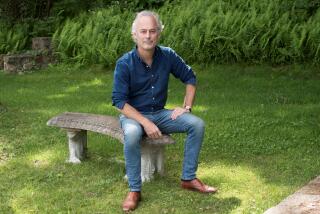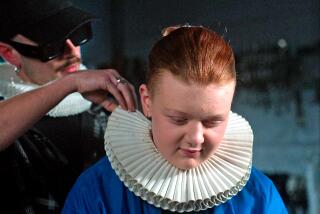Who was that masked man?
- Share via
“Wait till I die,” Orson Welles told me at lunch one day. “They’ll write all kinds of things about me. They’ll just pick my bones dry. You won’t recognize me, and if I came back to life and read them, I wouldn’t recognize me myself.”
And was he right. A cottage industry has emerged in recent years in both publishing and film, rewriting and reinterpreting our memory of the work and the life of this magnificently sweet giant of a man. Now we have the addition of Peter Conrad’s ambitious “Orson Welles: The Stories of His Life.” How timely. As Hollywood celebrates itself at tonight’s Academy Awards, as a billion people around the world tune in to watch the latest hoopla, it is good to be reminded once again -- however imperfectly -- of this great film artist, one who was dismissed by the “Industry” he adored as an amusing but irrelevant outsider throughout his remarkable career.
“I’ve told so many stories, you know, just to get out of situations, or out of boredom or just to entertain! Who can remember them all, but I’m sure they’ll come back to haunt me. Or rather, my ghost,” he would add with a laugh. “Don’t set them right, Henry. They don’t want to know. Let them have their fantasies about me. If only they just let me work. I never really cared about what they thought. Or maybe I cared too much, I don’t know.... But at all costs, don’t set them straight!”
Orson didn’t get a chance to write an autobiography. For years we talked about it, taped the lunches that we had once or twice a week, always with his idea that “when I’m no longer physically able to make a movie, I’ll use these tapes to write the damned book.” But, of course, he never did, except for one opening chapter that was published in an edition of French Vogue, a Christmas issue that he designed and illustrated for them.
How to review a book that proudly announces in its preface that it is not about Orson Welles but about “The Stories of His Life”? What does that mean? Whose stories? Stories told by him about others? About himself? Stories told by others about him? Stories that he selected to use as the basis for his plays and films? What can they all possibly have in common?
Peter Conrad’s book attempts to somehow sort out all these widely disparate “stories” and give them a kind of collective meaning, some cohesive biographical thrust that will, in fact, unravel the mystery that continues to hover about the seemingly enigmatic figure that Orson was to most people. He continues to present a compelling challenge to biographers: how to reconcile the brilliant child prodigy, the precedent-shattering stage director, the iconoclastic radio figure, the celebrated Shakespearean artist and the groundbreaking filmmaker credited by almost everyone with having made the greatest movie of all time with the TV talk show buffoon, the corny wine-commercial huckster, the willing participant in tasteless low-comedy “roasts,” the bloated, seemingly self-destructive outcast whose unfinished works and aborted projects became legendary?
“Orson Welles: The Stories of His Life” is an amazing book, a fascinating read, a whimsical journey of ideas and speculations that at times will leave you absolutely breathless. Unfortunately, it has very little to do with the real Orson Welles: Connections are made, relationships inferred and conclusions drawn that have no basis in fact and nothing whatsoever to do with the man himself.
In his life, Orson provoked all kinds of fantasies in all kinds of people, and the books that have been published about him demonstrate this. David Thomson invented a fascinating Orson of his own design but at least acknowledged that he was doing so. Simon Callow charmingly drew his conclusions from a highly subjective, intense identification with his subject. Barbara Leaming’s book came closest to the truth, but it was Orson’s truth, as he essentially manipulated how it was written and what was, and was not, revealed in it. Conrad’s book is an extraordinary example of this fictional biography genre, which in recent years has had so many practitioners.
We are all the summary of the stories told of our lives -- the stories we tell ourselves and the stories told by others -- so the idea intrigues. Arguably Orson Welles has had more stories told about him and his life than any other single theater and film artist of the 20th century. We’re not talking about the stories of how he made his films -- Peter Bogdanovich put together a lively and accurate record of that, the best we have, since it is in Orson’s own words -- but about Orson the man, the vulnerable, astonishing, quixotic, profound, infuriating, caring, lovely, silly child-man that he was, that has so far eluded all those who have written about him.
Conrad uses every conceivable strand of “evidence” he can muster (and he musters magnificently) to put together, Kane-like, his unique portrait of the great man. But his erudition often elucidates nothing. Open this book to almost any page and you will be drawn in by some unlikely -- and often bizarre -- analogy or linkage of absolutely unrelated facts and fancies that purports to prove something about Orson. There is a great deal of very creative silliness throughout, a naive yearning for answers and explanations, and where none exist or can be found, Conrad goes to great lengths to invent them. “For whatever reason,” Conrad writes in his preface, “Welles left us only fragments of himself. I have tried to piece them together.”
His book, however, tells us much more about Conrad’s wonderful imagination than it does about its subject. He calls Orson “a Renaissance man born in the wrong century,” though Orson was as contemporary and modern a figure as the 20th century would produce. Rather, it is Conrad himself who has a Renaissance-like abundance of seemingly endless interests and focuses, all of which he interweaves into what one must acknowledge is a truly magical tapestry of a book. Freely mixing facts and fictions about Orson’s real life with facts and fictions about the unreal characters that Orson created, Conrad seems to not know or care about the differences among them. He confuses Orson not only with the characters he created but also with the roles he played that were created by others. Orson’s many roles come together to prove some unifying, reductive thesis: Welles was thus and so. Just look at “Monsieur Verdoux,” Conrad will tell you, to prove a point. The fact that it was Chaplin and not Orson who played Verdoux is incidental to him. Orson wrote the original screenplay, so the character of Verdoux becomes, somehow, part of Orson. So much for fiction. Orson never made “Heart of Darkness” into a film, but the fact that he wanted to is enough for Conrad; it proves such-and-such. This simplistic reading of the artistic process is his book’s greatest flaw.
Conrad uses this technique to the book’s very end, where he applies it to Orson’s screen character in “Someone to Love,” his last appearance on film. The fact that his character’s name is not Orson but is referred to as “Danny’s friend” (and the fact that I play Danny in the film, which I directed) doesn’t give Conrad pause. He sums up Orson’s life and concludes his thesis by using the words Orson says in this final movie role as if they are interchangeable with Orson’s own thoughts. But Orson is playing a part, as he is in all the other roles of his lifetime, and they prove nothing at all about him. Danny and his friend are both fictional, a concept that seems to be of absolutely no meaning to Conrad if it gets in the way of his grand design.
Orson’s entire life and career involved his hiding behind masks. It was practically impossible for me, as director of my first film, “A Safe Place,” in 1970, to persuade him to play his part without some kind of mask. “What nose do you want?” was one of the earliest questions I remember him stumping me with. When I realized what he meant and told him, “No nose, your nose,” he acted outraged, as if I was revealing the ignorance of my youth. Two very unpleasant days followed before he summoned me up to his suite at the Essex House in New York City, where he triumphantly informed me: “OK. You win. No nose. I’m growing a beard!” It was, in fact, this beard, grown for his role as the lapsed Wonder-Rabbi spinning his Hasidic tales, that Orson wore for the rest of his life.
And it was, of course, a mask.
Onstage and on screen, beyond the mask of his makeup, he had always, as all actors do, hidden behind the mask of his characters. But for him it didn’t stop there. In personal appearances, on talk shows or when he found himself among strangers, he hid behind the mask of his outsized persona, the one that seemed so overwhelming and intimidating to so many people: the erratic, outrageous, somewhat ferociously aging wunderkind.
Because I had lunch with Orson once or twice a week during most of the last 10 years of his life, and because I spoke with him almost daily for much of that time, I was constantly amazed that the man I got to know so well in no way resembled the mythical being that everyone else saw and believed him to be. I discovered an incredibly open, deeply warm and profoundly human friend, one who was generous to an unbelievable fault, was caring, concerned and vulnerable to the point of such fragility that he could be wounded terribly by the unaware, casual, critical statement of almost any outsider.
I was always astounded by the way in which so many who did not know him viewed him as an arrogant, terrifying, egocentric ogre. They approached him with so much diffidence, fear and excited anticipation that his only possible response was to satisfy their expectations: The mask would win again. And though he bemoaned the isolation that this response inevitably brought him, he was oddly comforted by playing the part they expected, and did it with such force and style that it was captivating to watch, even as I would sometimes kick him under the table to get him to stop. His “Jewish conscience,” he would call me after they left, and then roar with laughter.
There were other masks as well.
Orson’s lifelong attraction to the art that has as its very essence the blurring of the line between reality and illusion was another piece of this same puzzle: Nothing gave him as much consistent pleasure as teasing audiences, and himself, with the many masks of magic. Even his physical being, as represented by his ever-increasing weight, became a mask for him to hide behind, in some infinitely more complex way. And no matter how seriously he dieted, no matter how insistently he swam his laps, no matter how often he made me eat the gourmet meals he denied himself in order to have me describe each of the tastes to him, his weight remained a mask that, once assumed, he was never able to drop.
More than anything else, Orson Welles was the invention of a brilliant, extremely sensitive and deeply lonely boy. And the ultimate image that developed from all the masks he used throughout his life to protect that boy became the very thing, of course, that defeated him in the end. As he grew increasingly isolated, trapped behind his masks, people quite naturally drew the wrong conclusions about who and what he was and added those conclusions, layer by layer, onto the rapidly growing mythology that attached itself to him over his lifetime and continues to attach itself -- as he predicted -- to his image nearly 20 years after his death.
Using the technique employed by Conrad, one could say that, as in the final scene of “The Lady From Shanghai,” it is ultimately impossible for the world to find the real Orson Welles among all the mirrored reflections he so busily set in place starting in his childhood. Unfortunately for us, “Conrad’s book continues to help Orson hide behind his masks, rather than finally revealing him to us in any meaningful way. Yet none of this should stop the interested reader from enjoying this thoroughly entertaining and highly imaginative undertaking.
Orson, you see, would have loved every page of it.
More to Read
Sign up for our Book Club newsletter
Get the latest news, events and more from the Los Angeles Times Book Club, and help us get L.A. reading and talking.
You may occasionally receive promotional content from the Los Angeles Times.






